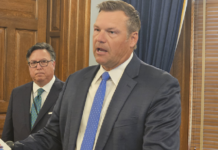Outgoing Republican Jeff Colyer’s parental leave idea for state employees is catching on elsewhere in state government.
The Kansas Supreme Court on Friday announced it would start offering paid parental leave to an estimated 1,600 court employees across the state.
Under the policy, court employees will receive up to six weeks of paid parental leave following the birth or adoption of a child.
The leave must be taken in the first 12 weeks immediately following the birth or adoption.
Currently, court employees must use paid time off or sick leave to care for a new child, a court spokesman said.
The new parental leave policy would extend to all employees who work for district courts across the state, including court administrators, court services officers, court reporters, clerks, and those in other administrative and clerical positions.
“To effectively compete for employees, the judicial branch must offer benefits and pay comparable to what is currently available on the job market,” Chief Justice Lawton Nuss said in a statement Friday.
“This leave policy is an action we can take to remain competitive while we continue to seek funding that allows us to pay our employees at market rates.”
The court’s announcement came about a month after Colyer signed an executive order extending paid parental leave to about 17,000 executive branch employees.
Like Nuss, Colyer said in a recent interview the parental leave policy was important for making the state more competitive in the job market.
“What we’re trying to do is have a modern, competitive” workplace, Colyer said. “One of the reasons we had to do this (was) so we could compete with the private sector so that we can have a younger, more dynamic workforce of state employees.”
Legislative leaders recently considered the idea of adopting Colyer’s parental leave policy for between 130 and 150 legislative branch employees.
They delayed making a decision so they could more thoroughly examine the fiscal effects of the policy.
















